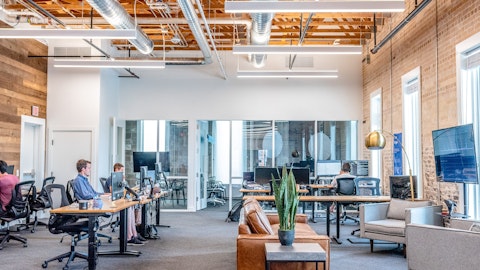Tyler Technologies, Inc. (NYSE:TYL) Q4 2022 Earnings Call Transcript February 16, 2023
Operator: Hello, and welcome to today’s Tyler Technologies Fourth Quarter 2022 Conference Call. Your host for today’s call is Lynn Moore, President and CEO of Tyler Technologies. At this time, all participants are in listen-only mode. Later, we will conduct a question-and-answer session, and instructions will follow at that time. As a reminder, this conference is being recorded today, February 16th, 2023. I would like to turn the call over to Hala Elsherbini, Tyler Senior Director of Investor Relations. Please go ahead.
Hala Elsherbini: Thank you, Emma, and welcome to our call. With me today is Lynn Moore, our President & Chief Executive Officer and Brian Miller, our Chief Financial Officer. After I give the Safe Harbor statement. Lynn will have some initial comments on our quarter, and then Brian will review the details of our results and provide our annual guidance. Lynn will end with some additional comments, and then we’ll take your questions. During this call, the management may make statements that provide information other than historical information and may include projections concerning the company’s future prospects, revenues, expenses, and profits. Such statements are considered forward-looking statements under the Safe Harbor provision of the Private Securities Litigation Reform Act of 1995 and are subject to certain risks and uncertainties, which could cause actual results to differ materially from these projections.
We would refer you to our Form 10-K and other SEC filings for more information on those risks. Also in our earnings release we have included non-GAAP measures that we believe will facilitate understanding of our results and comparisons with peers in the software industry a reconciliation of GAAP to non-GAAP measures if provided in our earnings. We have also posted in our investor relations selection of our website under the financials tab with supplemental information provided on this call including information about quarterly bookings, backlog and recurring revenues. On the events and presentations tab we posted an earnings summary slide deck to supplement our prepared remarks. Please note that all growth comparisons we make on the call today will relate to the corresponding period of last year unless we specify otherwise.
Lynn?
Lynn Moore: Thanks Hala. Our fourth quarter marked a solid finish to an eventful year as public sector demand remained strong and SaaS adaption continues at an accelerated pace. Today revenues grew 4.3% with organic growth excluding COVID related revenues of approximately 6% and organic revenue growth for full year was solid at approximately 8.2%. Recurring revenues comprise nearly 83% of our quarterly revenues. On an organic basis, subscription revenue grew 14.3%, reflecting both our acceleration to the cloud, and growth and transaction based revenues. Most importantly, SaaS revenues included in subscriptions grew 19.3%. We achieve solid revenue growth even as the shift and new software contract makes continue to accelerate to SaaS from licenses.
In Q4, 86%, of our new software contract value was SaaS compared to 77% in Q4 last year. In our digital solutions division, which is formerly known as NIC, we continue to execute on cross selling opportunities. And in Q4, we signed a significant new contract with the Kansas Department of Revenue to provide our data and insights assessment connect solution, which will work with our enterprise assessment solution used statewide in Kansas. We also signed sale through deals for our recreation dynamic solution with the Utah division of outdoor recreation, and the Mississippi Department of Wildlife, Fisheries and parks. Our digital solutions division also signed notable SaaS software agreements with the state of Nevada, and the Alabama Alcohol Beverage Control Board.
We also signed a payments processing contract with the Wisconsin Department of Motor Vehicles, which is our first payments opportunity in Wisconsin. Finally, our digital solutions division won a competitive rebid for our master enterprise contract with the state of Colorado’s statewide internet Portal Authority Board, as well as an extension of our master enterprise contract with the state of Oklahoma. In other Tyler divisions, we signed seven additional significant SaaS deals, each for different product suites and each with a total contract value greater than $2 million. Those include contracts with the Cypress Fairbanks Independent School District in Texas for our student transportation solution. The cities of prosper Texas and Glendora California for our enterprise ERP and enterprise permitting and licensing solutions.
The County Water Agency in California, and the City of Helena, Montana for our enterprise ERP solution, the City of Albuquerque, New Mexico for enterprise permitting licensing solution, and Lucas County, Ohio for our enterprise justice solution. In addition to those deals, we signed 12 SaaS deals in the quarter with contract values between $1 million and $2 million each. In the fourth quarter, we signed 153 new payments deals worth more than $4.7 million in estimated annual recurring revenue across Tyler divisions, other than digital solutions. The largest of those was an agreement to provide payment processing for the City of Milwaukee, Wisconsin, was estimated annual revenues of more than $1.2 million. For the full year 2022 we signed 571 new payments deals with more than $13 million in annual recurring revenue, many of which we were able to pursue because of the new capabilities that came to us with NIC.
More than 80% of those were sold to existing Tyler software clients. New payments only agreements typically have a lag of three to six months between signing and revenue generation. While payments agreements that are embedded in a broader solution, such as new ERP sale may have a period of 6 to 18 months from signing to revenue generation. In our justice group, we signed two notable multi suite license deals in the quarter for enterprise public safety enforcement, mobile and data insight solutions with Stearns County, Minnesota and Richland County, Ohio. We also signed two significant license contracts for our enterprise justice solution with Midland County, Texas and Kankakee County, Illinois, which also include our enterprise solution supervision solution.
Now I’d like for Brian to provide more detail on the results for the quarter and our annual guidance for 23.
Brian Miller: Thank you, Lynn. Yesterday, Tyler Technologies reported its results for the fourth quarter ended December 31, 2022. Both GAAP and non-GAAP revenues for the quarter were $452.2 million up 4.3% and 4.2% respectively organic revenue growth excluding COVID related revenues with 6% on a GAAP basis and 5.8% on a non-GAAP basis. COVID related revenues for the quarter were $3.5 million compared to 16.6 million in last year’s fourth quarter. Revenues from all of our COVID related initiatives have now officially ended. Licensed revenue declined over 60% as our new software contract mix continued to shift to SaaS at an accelerated pace. Professional services revenue rose 2.8% and 8.5% organically. And we intend to continue to grow our implementation teams in 2023 to support delivery of our growing backlog and pipeline that will likely continue to see some pressure on professional services revenue in the near term as the team ramp up to become fully billable.
Subscriptions revenues increased 11.9% and organically rose 14.3%. We added 140 new SaaS arrangements and converted 82 existing on-premises clients to SaaS with a total contract value of approximately $99 million. In Q4 of last year, we added 135 new SaaS arrangements and had 71 on-premises conversions, with the total contract value of approximately $74 million. Our software subscription bookings in the fourth quarter added $21.4 million in new ARR. Subscription contract value comprise approximately 86% of the total new software contract value side this quarter, compared to 77% in Q4 of last year. The value weighted average term of new SaaS contracts this year, this quarter was 3.9 years consistent with last year. Transaction based revenues which includes state enterprise portal, payment processing and E-filing revenues and are included in subscriptions were 146.5 million up 6.9%.
E-filing revenue reached a new high of 19.8 million up 12.7%. Our non-GAAP ARR was approximately 150 billion, I’m sorry, $1.5 billion, up 7.5%. Non-GAAP ARR for SaaS software arrangements was 440.6 million, up 18.5%. Transaction base ARR was 586.2 million up to 6.9% and non-GAAP maintenance ARR was slightly down at 469.1 million due to the continued shift of new clients and migration of on-premises clients to the cloud. Operating margins on the quarter were pressured by the acceleration of the shift to the cloud in new business and the related decline in license revenues as well as by an increase in R&D expense as certain development costs that we had expected to capitalize were expensed. Our backlog at the end of the quarter was a new high of $1.89 billion up 5.2%.
Bookings in the quarter were approximately $464 million, which was flat with last year. On an organic basis bookings were approximately 354 million up 2%. For the trailing 12 months, bookings were approximately 1.9 billion, up 9.5% and on our organic basis were approximately 1.4 billion up 1.6%. Capital expenditures for the year totaled $50.1 million below our Q3 guidance of $58 million to $62 million, primarily because of the reduction and capitalized software development that drove higher R&D expense. Cash flows from operations were 121.9 million up 6% and free cash flow was 114.7 million up 20.6%; both represented a new high for the fourth quarter. We continue to strengthen our already solid balance sheet throughout 2022. During the fourth quarter, we repaid $90 million of our term debt and since completing the NIC acquisition, we have paid down $755 million of debt.
We ended the year with outstanding debt of 995 million and cash and investments of approximately 229 million. As a reminder $600 million of our debt is in the form of convertible debt with a fixed interest rate of a quarter of a percent. The remaining $395 million in pre-payable term debt due in 2024 and 2026 with interest in flooding rates based on LIBOR plus a margin of 125 or 150 basis points. Thus our exposure to floating rates is limited. Beginning in February 2023 SOFR has replaced LIBOR as our reference rate. We also have an undrawn $500 million revolver. Our net leverage at quarter end was approximately 1.64 times trailing 12 months pro EBITDA. We’ve also issued our initial guidance for 2023. Please keep in mind that our outlook for 2023 includes no COVID related revenues as those initiatives were completed in the fourth quarter.

Photo by Dylan Gillis on Unsplash
For the year 2022 COVID related revenues totaled $51 million with $10.8 million in subscriptions, and 40.2 million in professional services. In addition, another revenue headwind that is factored into our guidance is the shift of two of our digital solutions state enterprise agreements from the gross to the net model for payments resulting in a 10.5% million reduction in revenues, although with a positive impact on margins. Our 2023 guidance is as follows. We expect both GAAP and non-GAAP total revenues will be between $1.935 billion and $1.970 billion. The midpoint of our guidance implies organic growth of approximately 8%. To add more color to our revenue expectations, we expect growth by revenue line to be in the following approximate ranges.
Subscription revenues will grow in the mid teens. Professional services revenues will decline in the high single digits but excluding COVID revenues will grow in the high single digits. License and royalty revenues will decline approximately 30% or more. Maintenance will decline in the low single digits. Appraisal services will grow in the high single digits and hardware and other revenue will be relatively flat. We expect GAAP diluted EPS will be between $4.10 and $4.25 and may vary significantly due to the impact of stock option activity on the GAAP effective tax rate. We expect non-GAAP diluted EPS will be between $7.50 and $7.65. Well, we don’t give quarterly guidance, we do expect first quarter EPS to be in the range of Q4, 2022 EPS with a significant sequential increase in Q2.
Interest expense is expected to be approximately $26 million including approximately $5 million of non-cash amortization of debt discounts and issuance costs. Other details of our guidance are included in our earnings release. And finally, while we don’t give specifically guidance on free cash flow, we want to point out a change in taxes that we expect will have a significant impact on our cash taxes and therefore our free cash flow. The tax cut and jobs act required that starting in 2022 research and experimentation expenditures known as Section 174 costs are required to be capitalized and amortized over either five years for expenditures in the U.S. or 15 years for those incurred outside the U.S. for tax purposes. Since the enactment of the TCJA businesses, including us have been monitoring congressional actions around this rule, and there was a strong expectation that section 174 would be repealed or delayed.
However, Congress has not yet taken action. While the section 174 change has a slight favorable impact on our tax rate it significantly accelerates the timing and amount of our cash tax payments. Now I’d like to turn the call back over to Lynn.
Lynn Moore: Thanks, Brian. During 2022, we achieved notable milestones towards several key strategic initiatives. We made meaningful progress on our cloud journey through continued investment in cloud optimization, and moving to cloud only deployment for many of our core solutions. Our intentional innovation is based on knowing our clients and anticipating their future knees. As you recall, in 2019, we launched a strategic shift from a cloud agnostic model to a cloud first model to deliver secure, scalable, dependable and compliant digital infrastructure. We’re pleased to see the accelerated pace of cloud adoption amongst our new clients, as well as the steady increasing pace of cloud migrations of on-premises clients. Additionally, we integrated our Tyler and NIC payments teams and launched a significant go to market strategy for payments with a growing and active pipeline.
During the year, we added 571 new payments clients with the vast majority at the local level. We leveraged our strong relationships across state and local agencies, including the NIC state enterprise contracts, to expand our cross sell opportunities with significant multi solution deals that demonstrate the power of our One Tyler approach. We’re still in the early stages of cross sell, and it’s exciting to see tremendous momentum and collaboration taking place. Since completing the acquisition of NIC synergies between NIC and Tyler have delivered 19 cross sell transactions worth $9.5 million in total contract value. Overall, the year was highlighted by significant wins highly successful upsell efforts and state renewals and expansions. Throughout the year, we also demonstrate a balanced yet opportunistic approach across our business and with respect to capital allocation.
We maintain a strategic lens toward acquisitions and close three transactions that bring innovative and robust offerings to elevate our digital solutions payments business, broaden our integrated solutions, and add new technology. All three acquisitions Quadrate, USC Direct and Rapid Financial Solutions support a unified client experience and further our connected communities vision to support thriving communities through a common digital foundation for better data access, engagement, and transparency. As we move into 2023, I’ve never been more confident about Tyler’s long term prospects. This is an important year in our cloud transition. And we are tracking well with our cloud optimization product development efforts and the plan to exit from our proprietary data centers in 2024 and 2025.
We expect to reach an inflection point in our cloud transition in 2023 with a significant decline in licensed revenues that are being replaced by valuable long term recurring SaaS revenue. As a result of the short term revenue headwinds from this mix shift, together with bubble costs related to SaaS transition, including duplicate costs of operating our proprietary data centers, while moving our hosting to AWS operating margins are expected to trough this year. The estimated impact of bubble costs on our 2023 non-GAAP operating margin is approximately 130 basis points. We are committed to returning to a trajectory of consistent operating margin expansion beginning in 2024. In fact, you’ll see in our upcoming proxy statement that we have added operating margin expansion as a second metric for our long term incentive plans for our senior leadership.
Our move to cloud first builds long term value and supports multiple long term growth drivers. In the midterm over the next five to seven years, we’ve talked about annual organic revenue growth in the 8% to 10% range, with consistent long term margin expansion of at least 50 to 100 basis points a year beginning in 2024 excluding the impact of merchant PCs from payments expansion. We continue to refine our Tyler 2030 plan and look forward to sharing our longer term vision and clearly defined targets for revenue, margin and payments growth during an investor day planned for mid year. Look for more details on that soon. When we look at our operating margins, it’s also important to consider the impact that growth in our payments business has on margins.
We recognize revenues for payment processing under multiple revenue models. A gross model for agreements, where we are responsible for merchant fees on the transactions, a net model where a client assumes direct responsibility for merchant fees, and a revenue sharing model similar to the net model where we are effectively reselling a third party processor services. The majority of NIC’s payment processing is under the gross model. And in 2022, we paid a total merchant fees of approximately $145 million with a small margin earned on those fees. If those same contracts were on a net basis, our consolidated non-GAAP operating margin would have been approximately 200 basis points higher. Our operational and financial discipline coupled with a strong balance sheet and ample liquidity allow us to aggressively manage our debt profile and moderate the impact of rising interest rates.
And delevering continues to be a priority for capital allocation. While the bar is high for acquisitions, we continue to have the flexibility to evaluate M&A prospects that present compelling strategic growth opportunities. To close I’m proud of our team Tyler team and what we continue to accomplish every day even amid macro economic uncertainty. As you’ve seen in our press releases, we received many industry and regional accolades, which is a testament to our work ethic, our culture, and our tireless efforts to support our clients’ needs. We also receive gratifying recognition for our environmental, social and governance practices, being named to the Dow Jones Sustainability Index North America for the second consecutive year. The DJSI cited are notable gains in IT security, risk analysis, privacy protection, and human capital development.
In addition, we were recently named to Newsweek’s list of America’s greatest workplaces for diversity. We’re proud of these recognitions, and remain committed to sustainable business practices. With that, we’d like to open up the line for Q&A.
See also 12 Countries that Export the Most Tea and 12 Countries that Export the Most Tobacco.
Q&A Session
Follow Tyler Technologies Inc (NYSE:TYL)
Follow Tyler Technologies Inc (NYSE:TYL)
Operator: We will now begin the question and answer session. Your first question comes from the line of Sami Badri with Credit Suisse. Your line is now open.
Sami Badri: Hi, thank you very much. And I had a question about the margin troughing in 23 and maybe you could just give us color on the ramp on from the bottom of 23 what should we be thinking about where margins could go and 24? And I think the big thing here is maybe you could give us color on like, what are some reasons why the bounce off the trough could be faster versus slower? And what are some things that could influence the speed of the margin movements?
Brian Miller: Yes. I think it’s still a little early for us to give much color around sort of how we see that trajectory playing out in 2024 and over the midterms over the next five to seven years. As we mentioned in the prepared remarks, we expect to have an investor day around midyear and provide more detail on that. But we’re still refining those models. So not really able to give a lot of color around that. As we’ve talked about some of the factors that give us confidence that we do return to margin expansion in 2024, particularly around the wind down of some of the bubble costs as we exit our first data center we think that this year, actually, we sort of reached that inflection point where the impact of declines in licenses are offset by the current stream of recurring revenues from subscriptions.
I think in terms of the factors that could make that go faster or slower certainly one of those is the speed at which our payments business grows. And Lynn talked a little bit about the impact that has on our blended margins. But on the software side, I think that the trajectory around the speed of the flips from our on-premise customers will have an impact on that. Some of the other efficiency gains and product optimizations as we wrap those up the ability to improve lower hosting costs, I think the speed at which those work their way into the model will also be a factor in how that trajectory, how fast that trajectory plays out.
Lynn Moore: Yes, I think just to amplify on that we’ve talked over the last couple of years we’re about three or four years or so into this cloud transition. And we’ve talked about sort of the two pieces of it, the getting dealer side on the revenue side, and then sort of getting the other side on the cost and expense side. And as Brian mentioned, on the revenue side, we’re seeing that sort of inflection point it’s going to take place, probably later this year. And last couple of years, the last licenses has been a significant impact. And our internal models are now showing that really the new flips, the gains from flip as well as the SaaS business over the last couple of years, is going to later this year, sort of past that point of where we lost licenses.
Remember, back in 2019, we did just over $100 million in licenses. So it’s a significant change that we’ve been running through the financials. And then when you look on the cost side each years go by as these, as time goes by, we’re getting better and better visibility where we are making progress on optimizing our products. We’re making more progress on our plans to exit our proprietary data centers. We’re getting better data on how our products are actually operating within the public cloud. And so a lot of that stuff gives us that confidence that 2023 is that margin trough. As we look out farther there’s other things that we’re doing as well. We have a lot of internal initiatives around efficiencies things like consolidating just some of our internal IT.




